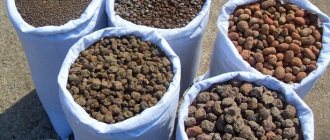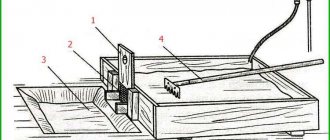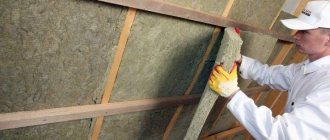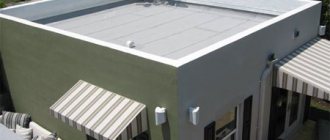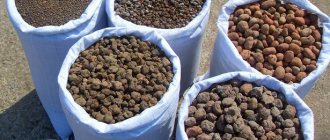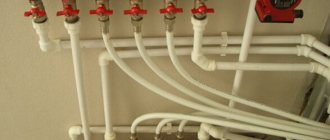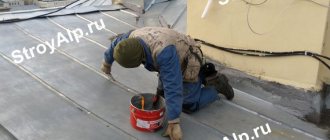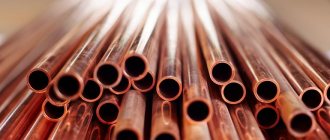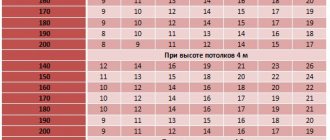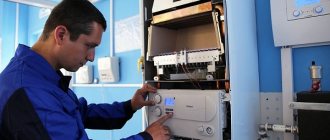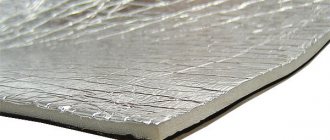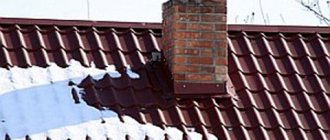Application of sealants
Sealing compounds are very popular during construction and repair work. They are a viscous or paste-like composition based on polymers. After application and hardening, sealants prevent liquid leakage through holes, gaps, openings and act as a waterproofing layer.
Most often, roofing sealant is used to seal joints and seams between sheets of base material. Sealing is especially in demand when arranging roofs with a small angle of inclination, from which water rolls off with difficulty. Sealants are also used to eliminate mechanical damage and other defects and to seal fastening points:
- chimneys,
- antennas,
- ventilation shafts,
- wooden poles,
- supports, piles.
Sometimes a strong wind tears off some of the sheets, they become deformed, and cracks appear on the surface. Cracks can also occur when trying to level the roofing material: even with high strength, the metal does not have sufficient elasticity and can be damaged by heavy loads.
Another possible reason for using sealant is a decrease in the protective properties of the anti-corrosion coating, because it also has its own service life, and after its expiration it deteriorates, peels off, and the surface begins to let moisture through microdamages. In such a situation, sealant becomes a temporary solution that will help you wait out the cold season until the roof is completely repaired.
What is roofing sealant (for roofing)?
Roofing sealant is a product for sealing, bonding, impregnating, repairing and creating permanent welds on roof surfaces, drainage systems, terraces, external walls, and foundations.
Roof sealants are easy to use and extremely durable. Their resistance to weather, extreme temperatures, ultraviolet radiation and water properties allows them to be used on virtually any surface of ceramics, glass, stone, wood, metals, plastics, concrete, asphalt and most other surfaces and building materials. The leading brands of roofing sealants are Tytan and Soudal.
Why seal your roof?
Sealing significantly increases the reliability and durability of the structure. Over time, any structure will inevitably wear out and collapse if you do not take care of its waterproofing in advance. The sealant has the following effects:
- stops the flow of moisture into the roofing pie,
- prevents the insulation from getting wet,
- protects the rafter system,
- prevents the appearance of fungus, rotting,
- protects unprotected areas from aggressive substances falling with rain,
- increases the overall service life of the structure,
- normalizes the thermal conductivity of the roof, insulates the house,
- eliminates leaks,
- is an adhesive substance for water vapor barrier.
Waterproofing for cold roofs under corrugated sheets
Cold roofs are relevant for non-residential buildings, utility blocks and most garages. They are made cold out of purely economic relations:
- such a roof is much cheaper than a roof with a full profile;
- there is no need to heat non-residential premises if this is not necessary;
- the installation process of such a roof is much simpler and faster than usual, due to the less complexity of the roofing pie;
- internal lathing;
- waterproofing layer;
- external counter-lattice:
- transverse lathing for corrugated sheeting.
A vapor barrier is not needed in this case, since there is no internal heat source. And since it is not there, there is nothing for moisture to condense from. Condensation will certainly form on the inside of the corrugated sheet. The daily fluctuations in its temperature are very significant. In this case, only antiseptic treatment and good waterproofing of the under-roof space will save wooden structures from rotting and fungus.
Important! The organization of a ventilated roof ridge covered with corrugated sheets is a mandatory procedure during its construction.
Types of sealants for metal roofs
Most often, metal is used for arranging roofs, which, in terms of technical characteristics and physical parameters, is well suited for this role. Despite its strength and aesthetic appearance, this material is susceptible to corrosion, which is accelerated due to regular temperature changes and the influence of atmospheric factors. Therefore, the roof sealant must be well suited to metal, be resistant to harmful effects and not peel off over time.
Based on the type of transition to the working state, there are two groups of sealants:
- Uncured. After application, they practically do not change consistency, so they penetrate into crevices and the smallest cracks. They can be used to seal any problem areas, apply them to the most complex structures, and repair large roofs. Sealants are available in the form of tapes and pastes. They can withstand temperature changes in the range of –60…+80 degrees.
- Curable. After completion, the seam hardens under the influence of oxygen, water, UV radiation, or as solvents evaporate. To prevent the polymerization process of the sealant from proceeding too quickly, curing inhibitors are added to the mixture.
Based on their composition, sealants are also divided into several groups, and they differ in strength characteristics and other parameters.
Polyurethane
Made on the basis of polymerized resin, they are a viscous, viscous mixture with high toxicity. Easy to apply to any substrate, they have many advantages:
- resistant to mechanical stress,
- work even at very low temperatures,
- are not destroyed by moisture and ultraviolet radiation,
- harden quickly
- serve for a long time,
- compatible with all roofing materials,
- may be painted.
Disadvantages of polyurethane sealants: they are quite expensive and toxic, as they are diluted with organic solvents.
Silicone
Silicone-based compositions are sold in tubes, pistol cartridges, and spray buckets. They are the most popular and have an affordable price. The products are multifunctional, resistant to temperature fluctuations, exposure to sunlight, and harden quickly. Silicone sealants are used for temporary and permanent waterproofing of roofs and other structures. There are acidic and neutral formulations on sale: the latter are more expensive, but more durable, non-toxic and odorless.
Polysulfide
Thiokol (polysulfide) sealants are made on the basis of modified resins and bitumen. They must be applied in a special way - in the form of several thin layers, and not one thick one, since oxygen and water vapor are needed for curing. Sealants are characterized by a universal purpose, serve for at least 15 years, and withstand differences from –40 to +140 degrees.
Polysulfide sealants also have disadvantages. They take a long time to dry - within 2-4 days, and the exact time depends on the thickness of the layer. The elasticity of sealants is low: their hardness resembles natural bitumen, so they cannot compensate for linear vibrations of materials. Under severe loads, there is a risk of microcracks appearing in the sealed seams, after which they begin to let moisture through.
Bituminous
They are also made on the basis of bitumen, but the latter undergoes a different technical treatment and is enriched with polymer compounds, and therefore acquires different properties. Such sealants are well suited for metal and soft roofs; they are viscous, durable, and can easily withstand low and high temperatures. Properties and capabilities of these tools:
- excellent penetrating ability,
- good elasticity and adhesion with most materials,
- protection of metal from corrosion,
- no cracks after drying,
- no reaction to UV radiation,
- preventing the proliferation of microbes,
- safety for humans, the environment,
- excellent moisture resistance.
Butyl rubber
Sealants of this group are made on the basis of isoprene and isobutylene, which form butyl rubber during copolymerization. The products are quite expensive, have excellent adhesion, elasticity, heat resistance, frost resistance, water resistance, and are characterized by a long service life. Butyl rubber sealants are sold in buckets, tubes, cartridges, and in the form of tapes.
Rubber
The products are made on the basis of artificial rubber and are considered universal, as they are suitable for different types of work. They withstand severe temperature changes, harden quickly, and are characterized by low toxicity. Many compositions are not very resistant to mechanical stress.
Acrylic
Acrylic sealants are characterized by their low price, long service life, and excellent quality. If you apply this composition to a dry surface, according to the instructions, the adhesion rate will be the highest, and with any type of coating. Acrylic sealants are odorless, environmentally friendly, and do not contain solvents. They are sold in different forms (cans, tubes, buckets, cartridges) and in a wide range of colors. The downside is that the water-repellent properties are not the highest, since the composition contains an aqueous dispersion. It is better to use together with sealing tape.
Two-component formulations
Such products can be made on the basis of different components: epoxy resin, urethane groups or silicone rubber. They are represented by two components: a base and a hardener, which must be mixed together before use, after which the suitability of the sealants will be limited to minutes or hours, depending on the specific type. Then polymerization of the base begins, it loses its fluidity and hardens.
Roofing mastic
Roofing mastics are very popular in construction. They are viscous plastic masses based on resins, rubber, bitumen with the addition of fine fillers: talc, graphite and others. Bitumen mastic is much cheaper than polymer mastic, but the latter has a high degree of adhesion and elasticity. Most often, mastics are used to strengthen and waterproof soft roofs.
Tape sealants
The easiest way is to use tape sealant, especially if a beginner is doing the work. The characteristics of sealing tapes are as follows:
- resistance to temperature changes, sunlight,
- possibility of quick application and replacement,
- high degree of tightness,
- sufficient mechanical strength.
Patches, wide or narrow strips are cut out of the sealant tape, depending on the need. The material is inexpensive, so the cost of sealing the roof will be low.
Pairing corrugated sheets with additional elements
The junction of corrugated sheeting with a ridge strip is the most complex element of external roofing work. It is important that the skates are attached not only to the metal of the profiled sheets, but also to the wooden base of the rafter system. Fastening is carried out with roofing screws into the crest of the stiffener, through the side of the ridge. Fastening is carried out in each wave.
The distance between the top edges of the joined sheets should not exceed 50 mm.
Even with a perfect fit of the ridge, there will be gaps between the ridge and the corrugated sheet between the crests of the waves. Rain is unlikely to penetrate such gaps, but snow can easily get into the under-roof space. Even with a small height of the stiffeners, filling the voids with sealant alone is not economically feasible. The basis for applying silicone can be pieces of extruded polystyrene foam or polyurethane foam that fill the cavities between the ridge and the sheet. But liquid polyurethane (spray foam) must be used extremely carefully to avoid compromising the integrity of the roof.
The valley strips are connected to the corrugated sheeting in the following sequence:
- Fastening the bottom strip to the sheathing using a 4.2 x 25 mm press washer with a drill and a washer with a rubber gasket. You can see how this is done in the video:
- Installation of corrugated sheets.
- Installation of the upper (decorative) valley is carried out using roofing screws.
- Sealing the joints of sheets and the upper valley with polyurethane foam and sealant.
Wall extensions protect the roof from moisture penetration between the wall and the profiled sheets.
Metal parts are connected with roofing screws. Such planks are attached to the wall with dowels (brick) or a press washer with a rubber gasket. The joints between the wall and the wall strip are sealed with tape sealants. The interfaces between sheets and extensions are treated with rubber or silicone sealants.
Installation of front and wind strips is carried out directly on sheets of corrugated sheets using roofing screws and does not require sealing.
Author of the article:
Sergey Novozhilov is an expert on roofing materials with 9 years of practical experience in the field of engineering solutions in construction.
Corrugated sheeting, as a roofing material, is at the very top of its popularity today. And all due to a completely new approach to its production. This is no longer just a gray galvanized sheet with a ribbed surface. This is a huge variety of paints with high anti-corrosion qualities. Manufacturers offer an improved model coated with a polymer protective composition. Plus the low price, that's why it's very popular.
In addition, covering a roof with corrugated sheets yourself is not difficult, but you need to take into account some subtle aspects of the installation process. One of them is sealing joints. This is how we can be guaranteed to talk about high-quality work on covering the roof with corrugated sheeting. What do experts suggest, what materials can be used to seal the joints of the structure?
Let's start by identifying those places (joints and cracks) that need to be sealed.
- These are the places where the roof meets the wall.
- Places where corrugated sheeting joins chimneys and ventilation ducts.
- Joint between laid profiled sheets on a roof with an inclination angle of less than 12°.
- Valleys, ridge and cornices.
Attention! According to the last position, it is recommended to apply a sealable layer to the upper wave of the lower sheet.
Materials for sealing joints of corrugated sheets
Basically, sealants and special tapes are used to protect joints in corrugated roof structures. Let's look at each of the materials and determine their quality characteristics.
Sealants
The modern building materials market does not offer a very large range of sealants. The thing is that they are based on polymer components that are used today in various areas of construction and industry, and they have begun to appear very often in everyday life. There are not many such polymers, hence the meager assortment.
Silicone
So, I wanted to name silicone sealant first in the model line. According to its purpose, it is a universal sealing material that is used almost everywhere. Silicone itself is an organic compound based on silicon, hence its high adhesive properties; it can be bonded to almost any materials used in construction. Therefore, we can say that this option is the optimal solution if the task is to seal the joints of corrugated sheets on the roof.
The silicone sealant itself is very dense, but at the same time very elastic. Its main quality is to withstand a fairly large temperature difference. This is an ideal option for corrugated sheeting, because a metal roof gets very hot during the day and cools down quickly at night. Let's add to the positive characteristics the elasticity of the applied layer after application, which does not lead to cracking, plus silicone is resistant to sunlight. For a roof, this is one of the important requirements.
The disadvantages include:
- Do not apply to wet joints.
- Does not stain.
Thiokol
This sealant is also called polysulfide sealant because it is based on bitumen. For corrugated roofs, this is not the most ideal option for sealing joints. Its ability to harden under any conditions is surprising. Even a temperature difference from -40C to +40C will not make it soft. Manufacturers claim that the service life of thiokol sealant is 15 years.
Attention! There is a recommendation from the manufacturer - to apply this sealing agent in thin strips in several rows. The material will harden quickly, but it will gain full strength in two to three days.
The strength of the sealant is its disadvantage when it comes to sealing the joints of corrugated sheets on the roof. The thing is that a metal profiled sheet, under the influence of temperatures, either expands or contracts. So the joints are subject to heavy loads throughout the day. Therefore, we can say that thiokol sealant is not the best option in this case.
Polyurethane
Probably, speaking about polyurethane sealant, we need to remind you about polyurethane foams. After all, this is one of its varieties, or rather, it is a foamed polyurethane sealant. This material has excellent thermal and waterproofing characteristics and increased adhesion to any materials, even to itself.
The only drawback is that when exposed to sunlight, it turns yellow and loses its positive qualities. Therefore, it is recommended to use it in those places on the roof where the joints and crevices of the corrugated sheeting are in the shade, away from sunlight, especially direct sunlight.
Today, however, more and more manufacturers are focusing on new models of polyurethane sealants that are not afraid of either the sun or changes in temperature and humidity. And if the classic compositions are one-component solutions, then the new ones are two-component ones. By the way, the development of these types was carried out by the TechnoNIKOL company, which represents them on the Russian market.
There is another type of PPU sealants - these are liquid mixtures. They are usually applied to the joints of corrugated sheets with a brush or roller; there are even cases when the application was made with a spray gun, after which a durable polymer layer that is one hundred percent waterproof was formed between the sheets. The guaranteed service life of the mixture is 20 years.
Many experts today give their preference to liquid polyurethane material. But today it is the most expensive sealant, although with the lowest material consumption.
Acrylic
This option is the most environmentally friendly and can withstand almost all natural loads. It is based on acrylic resins and water, so it is not afraid of high humidity and precipitation. It is also not afraid of sunlight and can withstand frosts down to -15C. Plus, acrylic sealant is easy to paint, so the joints of the corrugated sheets will be almost invisible.
A purely acrylic composition is not used for sealing corrugated sheet seams, because after three to four years it fails and simply begins to crumble, so it is recommended to use its siliconized version. This is a symbiosis of silicone and acrylic. True, there is one point in its use - it can only be used from the attic.
Self-adhesive tapes
Today, sealants are increasingly being replaced by tapes and cords made from butyl rubber. They are self-adhesive, so there are no problems with installation and fastening.
Their positive qualities:
- High moisture resistance;
- Chemical resistance;
- Good elasticity;
- Withstands differences from -60C to +90C.
There are also liquid materials in this category that are applied to the joints with a spatula.
Conclusion
And in conclusion, we invite you to watch the video:
- Internal drains: standards, SNiP
- Plastic roof drain
- Do-it-yourself drain from sewer pipes
- Rules for installing gutters
One of the most important measures during any construction is reliable sealing of the roof. Much depends, of course, on the quality of the roofing and the method of its installation.
But this alone is not enough - all even slightly vulnerable areas must be carefully isolated from moisture.
There are special hermetic roofing compounds for this purpose. Proper selection of the right product will ensure proper treatment of any type of roof.
After its use, the roof will not allow moisture to pass through, will be more durable and repairable.
Choosing the right sealant for different surfaces
Some compositions are considered universal, others are suitable only for a specific roofing material, but do not exhibit high adhesion to other coatings.
For metal roofing
For a product to be suitable for metal, it must have reliable adhesion to stainless steel, carbon steel, and alloys. A good sealant has high elasticity, is resistant to precipitation, and is not destroyed by vibration. Polyurethane, bitumen, and bitumen-rubber sealants are best suited for metal roofing. It is these compositions that are characterized by a sufficient degree of plasticity, and therefore serve for a long time.
Some products can even be applied to wet surfaces, which is very important when carrying out emergency repairs. Silicone acid compounds cannot be used for metal roofing: they provoke rusting.
For corrugated roofing
In order for the roof to serve faithfully, during installation you should follow the recommendations for the maximum slope (14 degrees), and also be sure to process the transverse joints of the corrugated sheets. Polyurethane sealant, which has high waterproofing properties, is excellent for this material. It is important to install or repair profile sheets when they are completely dry and clean. The sealant is applied in a layer of 3 mm; if necessary, the seam is covered with sealing tape.
For soft roof
Flexible tiles are the most inexpensive and popular type of material, which is especially often used for arranging country houses. For complete sealing, bitumen mastics and emulsions are used. For local repairs, products such as liquid rubber based on rubber and silicone are suitable. Seams and joints are sealed using sealant tape. All products, except bitumen mastics, are applied only to dry surfaces.
For metal roofing
Metal tiles are similar in properties and installation to corrugated sheets. Typically, silicone sealants with increased resistance to UV radiation are used to seal cracks up to 5 mm in size. Longitudinal and transverse joints are treated with bitumen or polyurethane compounds; the same means are used to seal the seams between the chimney, ventilation outlets, antenna and roof.
Tips for choosing
When giving preference to one or another type of sealant for a metal roof, make sure that it has the properties of resistance to high atmospheric degrees, elasticity, tolerates moisture and frost well, and has a short hardening time.
These requirements are met by silicone roofing high-temperature composition. If you have to treat the roof in relatively cool latitudes, a polyurethane-based sealant is quite suitable. You should pay attention to acrylic sealant as one of the optimal price/quality ratios.
The adhesion of the above materials to the polymer coating of the corrugated sheet can be increased by using special substances that improve adhesion. Perhaps the best choice for treating the joints of corrugated sheets and metal tiles would be silicone sealant.
Where exactly are sealants used during roofing work?
Some areas are more susceptible to damage than others, so sealing compounds must be applied to them with special care.
Endovy
The structural elements of the roof, which represent the angle at the junction of two slopes, are the most complex units and are considered key in the arrangement of the entire roof. An error in the design and formation of any valley causes intense leaks, and when snow accumulates, it can lead to roof collapse.
Since all atmospheric precipitation converges in the valleys, they are subject to serious mechanical stress and are constantly exposed to climatic influences. Since the metal sheets in this area are cut, water can seep under individual elements. The overlap areas between the slats of the lower valley are well coated with sealant, which deflects water coming from the slopes. Without sealing, you can notice a leak in an area even if it is seriously damaged and there is a need for expensive repairs.
Chimneys, ventilation pipes, other engineering structures
In such places, you can do the sealing yourself, as it is not difficult. All joints around the perimeter are treated with the selected composition, without missing a single section. This will help prevent roof leaks in the most “popular” places: at the junction of the main material and overhead structures.
Drainage systems
There are gutters on every roof, and for maximum tightness of the areas connecting the gutters with the attachment point, it is necessary to use a specialized compound. The metal drainage system should be treated especially carefully in the area where it joins the roof.
Connections to vertical walls
There is a high probability of leakage in the area of vertical sections and the places where they connect with horizontal ones, unless these areas are first coated with a reliable composition. In addition to sealing, it is important to strictly adhere to the technology for constructing joints - using chipping or sawing of brick surfaces.
Cornice units
Sealants help glue the membrane to the metal strip, securely fixing and holding this material. When using a high-quality composition, the membrane gasket will not be torn off by strong winds, and water will not be able to seep under it. It is also necessary to coat the side junctions and overlaps of the joints of the corrugated sheets with the product, so that during slanting rain or spring melting of snow, leaks do not appear.
Which sealant for a corrugated roof is better to choose?
A metal roof sealant must have the following properties:
- Elasticity;
- Resistance to high temperatures;
- Moisture resistance;
- Frost resistance.
- Fast hardening.
High-temperature silicone sealant is best suited for these requirements.
for the roof. The second option is to use a polyurethane roofing sealant, unless, of course, you live in the south.
Both of these materials have reduced adhesion to polymers, so before applying them, the surface will need to be treated with special compounds that will increase adhesion to the surface.
Thus, silicone joint sealant is an almost ideal option for sealing the roof in areas where corrugated sheets overlap. Other compositions must be used carefully, paying particular attention to their temperature limits.
Useful article? Save it on social networks so you don’t lose the link!
Top ↑
Team oprofnastile.ru
Read on topic:
How to attach corrugated sheeting to the roof: rules, subtleties and possible mistakes
Find out how to properly attach a profiled sheet to a roof and what needs to be done to ensure that your roof serves you for many years and does not undergo premature corrosion and destruction.
How to properly mount a ridge for corrugated sheeting?
Do you want your roof to last 40 years, not 5? Read the article and find out how to properly install a corrugated roof ridge and ensure high-quality roof ventilation.
Popular brands
There are many products on the market that are suitable for sealing roofs. The most famous:
- “Titan” - easily withstands frost, can be used with any materials, perfectly seals flat and seam roofs,
- “Sazilast” - it can be applied even at sub-zero temperatures, after hardening it exhibits a high degree of adhesion,
- SOUDAL Aquafix - suitable for wet and underwater surfaces, allows repairs in rainy weather, ideal for metal tiles and gutters,
- Ceresit is resistant even at abnormally low temperatures, after curing it resembles plastic, therefore it is not used on deformable substrates,
- RoofPlast is based on bitumen and is considered one of the highest quality sealants.
Roof seals
For good protection of the under-roof space from rain, snow, debris and dust, roofing seals are used. They are attached at the junctions and junctions of roofing elements to the supporting structure.
- hard (specialized);
- soft (universal).
Rigid seals follow the profile shape of the roofing sheet, so they adhere to the metal tiles without gaps. Thus, seal profiles exist in different shapes: straight and reverse (upper profile wave or lower wave).
Scheme for sealing the end sides of corrugated sheets using butyl rubber tape.
These seals are made from high pressure polyethylene foam (HDPE), which has closed cells. PVD seals create a fairly complete seal, which eliminates roof ventilation. For the necessary circulation of the roof, ventilation holes are made in the seals.
Rigid seals are used at the junction between the ridge, at the junction of roofing elements to the wall, and roofing accessories to metal tiles. For each type of corrugated sheeting and metal tiles, cornice and ridge seals of the appropriate shape are produced.
PVD seals have good moisture resistance, resistance to chemical attack and combustion.
The soft seal is universal: it can take any shape, and therefore can be placed anywhere on the roof. It is a rectangular profile 40 x 50 mm and 1 m in length. This material is made from polyurethane foam. This seal provides sufficient ventilation due to its good porosity. It absorbs moisture and vapor from the interior well, but does not allow rainwater and snow to enter.
Thus, the soft seal serves as a barrier against roof leakage and at the same time does not interfere with normal air circulation.
This material is self-adhesive. It is enough to remove the protective layer from the adhesive side of the seal and press it tightly, for example, to the ridge of the roof. That is, such a sealing material is indispensable for sealing the joint between the ridge and the metal tile.
Compaction with this material can be done even in slight frost. It is wear-resistant and resistant to fungi and combustion.
Roof sealing is the key to long-term roof service without leaks.
After the roofing has been laid, it is necessary to carefully insulate all its areas from moisture penetration. This is done using special roofing sealants, which are available for sale in a fairly wide range: this makes it possible to choose the most suitable option for a particular roof.
Subtleties of working with sealant
To carry out roofing work, you need to know the features of using a particular sealant. For example, two-component formulations must be mixed correctly: according to the instructions, in compliance with the proportions and timing. It is usually recommended to stir with a drill at medium speed for 10–15 minutes. It is advisable to carry out the procedure in a warm room, since in the cold the mass thickens greatly, and it is forbidden to dilute it with a solvent.
Sealants should not be applied to wet concrete or icy surfaces. The result will not be of high quality if you treat the lid with sealant at temperatures below –25 and above +50 degrees. The thickness of the layer of the composition should not be more than 3–4 mm, while sagging and tears are excluded. The easiest way to apply sealant is with a special gun, since manual extrusion often results in crooked seams. To ensure that the composition lies evenly, the areas around the seams can be covered with masking tape, and only then begin applying the composition. After the product has completely dried, the roof will be ready for use: it will be reliably protected from leaks for a long time!
Prices for various bitumen sealants
Let's start with acrylic roof sealants. The prices for such compositions on the Internet vary. Popular trading platforms offer mixtures from various manufacturers and with various additional components in the composition. We will consider tubes with a capacity of 310 milliliters. Such a container costs from 94 to 256 rubles. The best option can be purchased for 170 – 200 rubles.
Silicone and rubber compounds have a slightly higher price. So the cheapest sealant in the same 310 milliliter tube will cost about 130 rubles. The most expensive one costs 450 -460 rubles. The optimal composition in terms of price and quality will cost you 220 rubles.
Bituminous sealants have average price indicators. The cost of a tube on the Internet is set in the range from 170 to 260 rubles. The choice of such a composition is the most optimal, because the low cost is combined with a number of advantages of this material.
The price of the sealant depends on the volume sold and on the composition of the sealant Source stroy-vdom.ru
